USAAF B-24J Liberator 42-99991 ‘Bachelors Baby’
‹ Return to USAAF Crash Sites 1942 – 1945

B-24J 42-99991 – scroll down for photos of the crash site
The image above shows the approach from Anglesey. The B-24 struck the hill on the right and skimmed across the moor, before coming to a halt and burning out.
7th January 1944. American bomber B-24J Liberator 42-99991 ‘Bachelors Baby’ had started the last leg of a long journey from Kansas to Norfolk but crashed within a few minutes of take off from RAF Valley on Anglesey.
On board were 10 crew members, one passenger and a dog. Two of the crew, the passenger and the dog died at the scene, while 2 more crew members later died of their injuries.
The B-24 had made the journey to Britain from the USA via the South Atlantic ferry route which took in landings at Florida, Puerto Rico, Trinidad and Brazil, then across the Atlantic to Dakar and then Morocco before arriving at Anglesey.
Below; Liberator 42-99991. Many thanks to Alan Starcher for pointing out the incorrect photo previously provided here and to Dan Stockton of B24BestWeb for kind permission to use this photo.

For this last part of the journey to RAF Watton, the crew were joined by a passenger, Technical Sergeant Nicholas Cennemo who had missed his own flight and was hitching a ride. The dog on board was the crew’s mascot, a fox terrier pup named Booster.
Below; photo showing 4 of the crew L-R Sgt Nichols, Staff Sgt Offutt, Sgt Alexander with Booster in his jacket, and Sgt Nieglos. This photo is from “No Landing Place: More Tales of Aircraft Crashes in Snowdonia volume 2” by Edward Doylerush and is credited to Hal Alexander
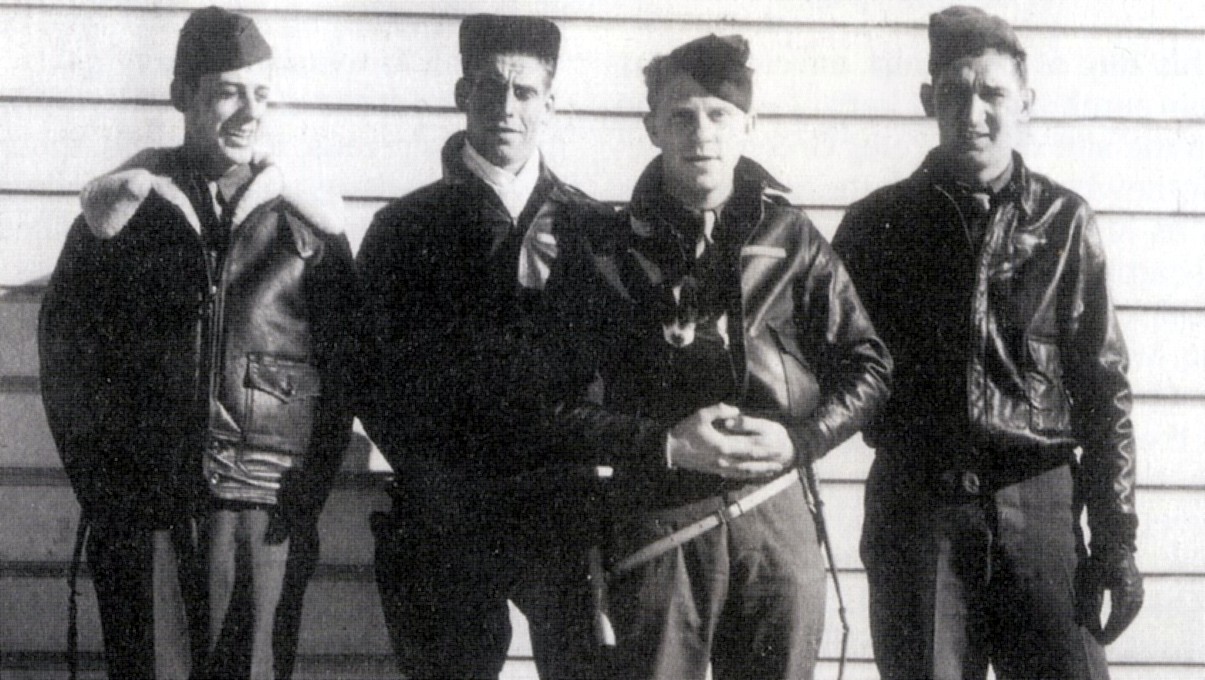
Below; Another crew photo. This is from “No Landing Place: A Guide to Aircraft Crashes in Snowdonia” by Edward Doylerush (the main source of info for this piece) and is credited to A.J.Schultz.
L-R Back – Schultz, Davis, Boyer, Erts,
L-R Front – Offutt, Tymczak, Nieglos, Lorenz, Nichols, Alexander.

The crew were not entirely in their normal positions for this short journey; 2nd Lt Erts was on the floor of the flight deck, according to Doylerush, along with Sgt Nieglos who was holding Booster. Technical Sergeant Cennemo and ball turret gunner Sergeant Nichols were in the waist section of the B-24 along with waist gunner Sergeant Lorenz.
Below; Diagram showing crew positions

The instructions to the crew were to follow the escort, a B-17G Flying Fortress piloted by F/O L L Dorrie, to Watton in Norfolk. The conditions were poor as they took off at 13.45 with low cloud just 300 feet above sea level and the hills of north Wales completely shrouded by clouds and rain.
Second Lieutenant Adrian Schultz, pilot of the B-24, had orders to fly in formation with the B-17. However shortly after take-off, he began to lose sight of the escort in the low cloud. F/O Dorrie in the leading aircraft instructed him to hold altitude and course which would have taken them along the coast over Rhyl to Chester, but 2nd Lt Schultz replied that he did not know the course and radioed back saying he would meet up with the B-17 above the clouds (the B-17 had already broken through and was above the clouds) and the Liberator began a slow climb.
Bachelors Baby never broke through the clouds to meet up with the escort. F/O Dorrie in the B-17 escort circled Conwy Bay at 500 feet, calling 2nd Lt. Schultz on the same frequency for 15 minutes before returning to Valley where the tower continued to call 42-99991.
Below; My map showing the places mentioned in this narrative

The B-24 was seen by people in the town of Llanfairfechan flying low over the town. Someone on the B-24 called out “look out for the white house!” as the bomber clipped the roof of Plas Heulog on the outskirts of the town and took off the tops of some trees.
Below; Plas Heulog

Second Lieutenant Schultz urgently put on more power and tried to climb, but moments later, and with Booster reportedly screeching uncontrollably, the bomber hit a craggy outcrop of a hill called Clip yr Orsedd.
Below;
The rocky outcrop (referred to in Doylerush as Mynydd Bach) below Yr Orsedd. The B-24 struck here before becoming airborne again

The impact with the hill tore off the bomb-bay doors and stuff from the aircraft was strewn across the hillside. However, the aircraft carried on flying, albeit without the pilot in control, and the bomber skimmed the moor for 500 metres before coming to earth in a 100 metre skid, sliding to a halt below the hill of Moelfre, turning as it did so.
There would have been more survivors had a fire not broken out, fuel in the tanks in the wings pouring into the waist section of the aircraft.



Second Lieutenant Schultz spotted a hole torn in the cockpit floor and he and 2nd Lt Erts hauled the badly injured co-pilot Second Lieutenant Davis out of the wrecked aircraft. 2nd Lt Erts was himself injured and had to lay down on the moor, trying to keep out of the way of ammunition which was cooking off in the fire. Second Lieutenant Schultz however, returned to the aircraft to try to help S/Sgt Offutt.
The engineer / turret gunner had been trapped when the gun turret ring gear fell on him. It would appear that Sgt Nichols and passenger Technical Sergeant Cennemo also died in the fire in the waist section of the aircraft. Sergeant Lorenz was pulled from the wreckage but died of his wounds at the Caernarvonshire and Anglesey Hospital in Bangor the day after, as did Second Lieutenant Davis, the co-pilot.
Doylerush says that Booster was killed in the initial impact with Yr Orsedd.
Somehow Sergeants Tymczak and Nieglos managed to get away from the burning wreck and survived.
2nd Lt. Boyer had thought he was the only survivor as he clambered from the wreck when he heard 2nd Lt Erts, who was trying to hide from the exploding ammunition. The bombardier then heard Sgt Alexander trapped in the rear turret and went to help him. Once Sgt Alexander was free, 2nd Lt. Boyer turned his attention to Sgt Lorenz, and hauled him out of the wreck, though as noted above, the waist gunner died of his injuries shortly afterwards.
Second Lieutenant Boyer then set off in what he thought, in the low cloud covering the moor and the confusion of the crash, was the line of flight back to the coast and the town they had just passed. However, the Liberator had turned in its last moments and the direction 2nd Lt Boyer set off on was not west to the coast, but south east and into the mountains. See map above.
Below; 2nd Lt Boyer left the crash site to find help but headed further into the hills
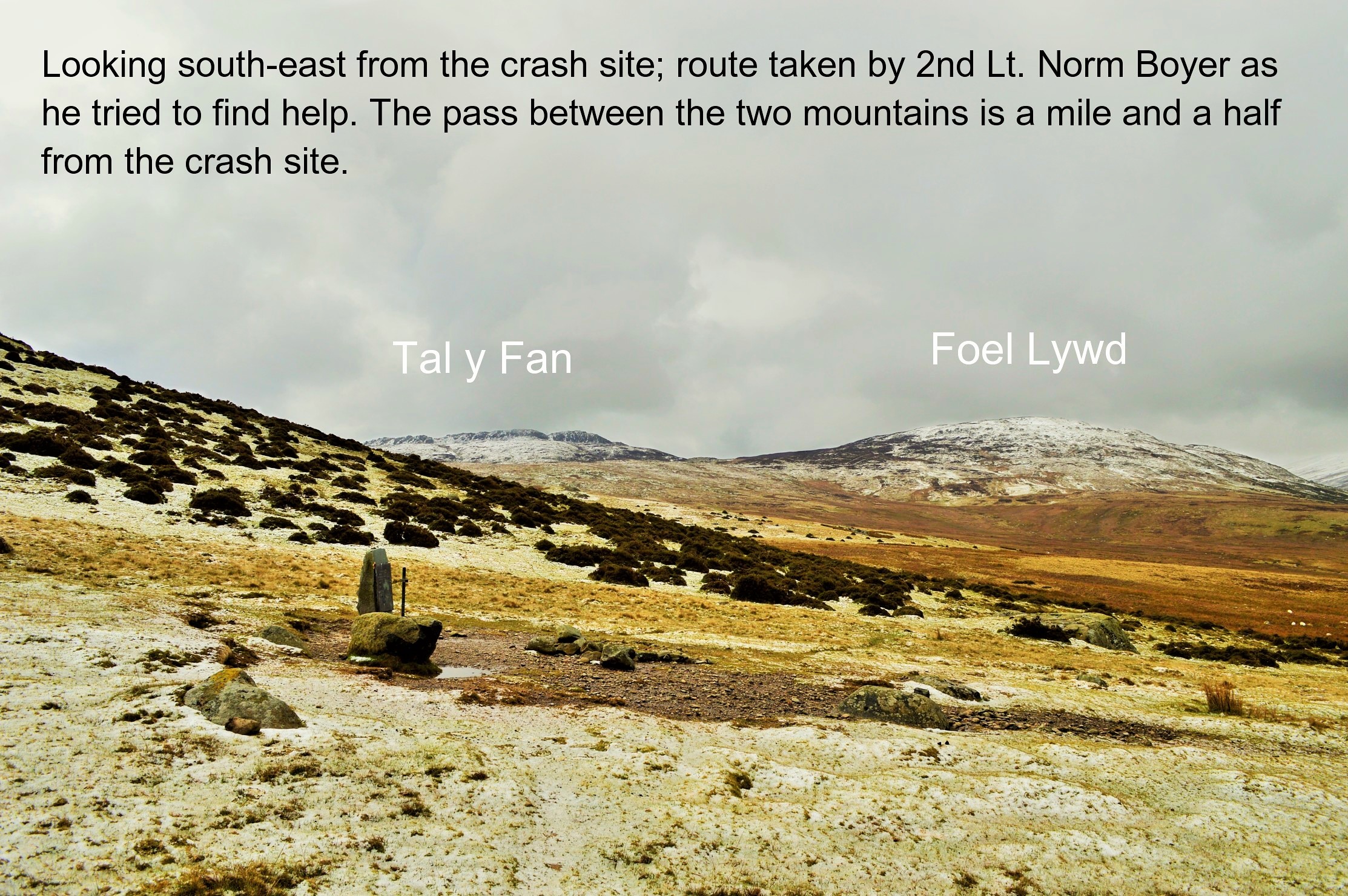
Although he could not see much of the terrain around him, 2nd Lt. Boyer tramped across the moor in the rain and low cloud and across the pass between Tal y Fan and Foel Lwyd, a mile and half from the crash site. He walked 4 miles before he eventually met someone who could help him. His route took him over the pass and down to a holiday cottage at Hafoty Gwyn which had been locked up for the winter. 2nd Lt Boyer broke in and lit a fire to dry himself out.
Below; Hafoty Gwyn as it looks now
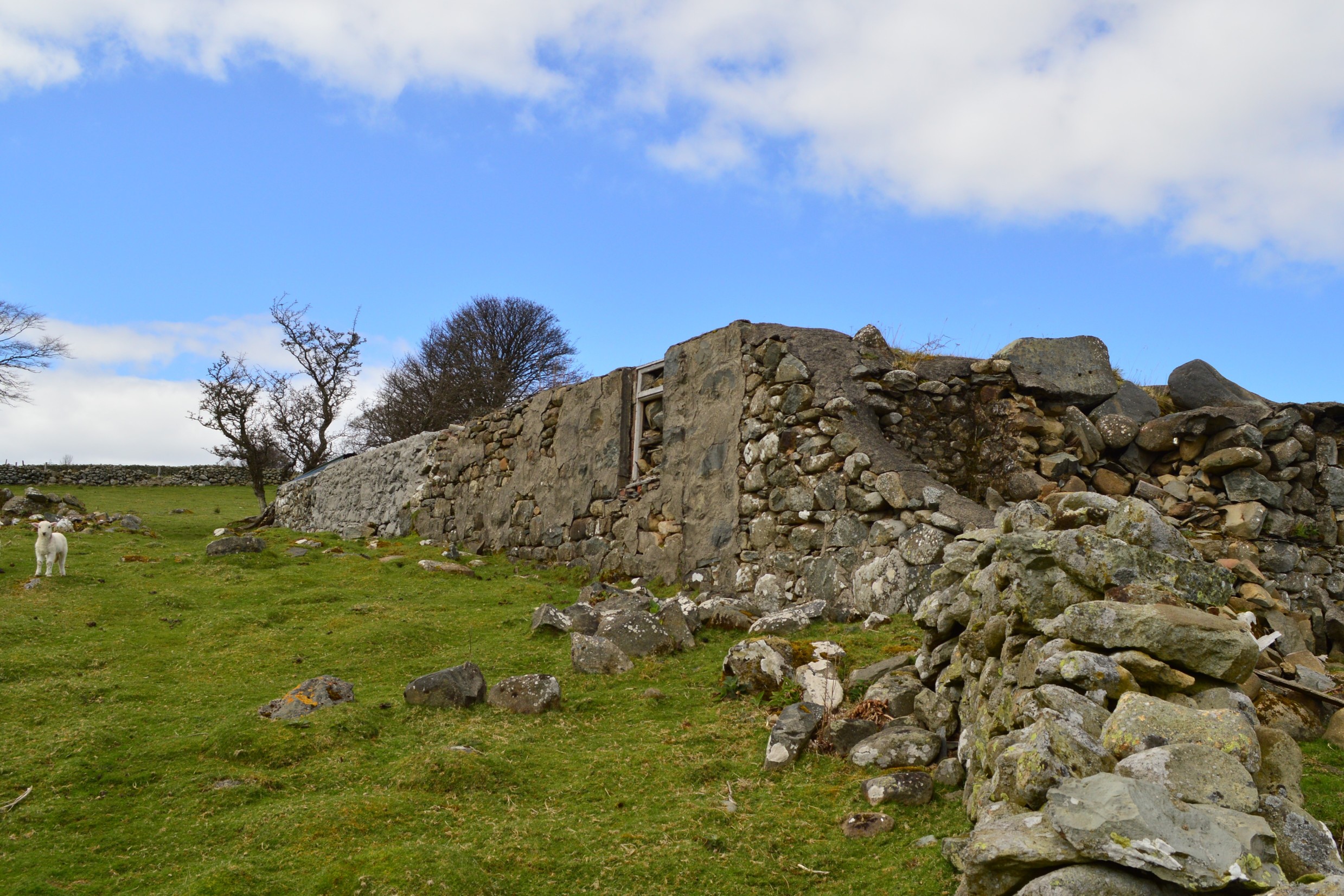
Having warmed himself a little, he left some money on a table, and continued further along the road, climbing a dry stone wall upon seeing a farmhouse. Here at Waen Newydd the Roberts family provided some dry clothes before taking him to Llandudno General Hospital.
Below; Second Lieutenant Boyer would have climbed this wall to get to the farmhouse at Waen Newydd where he at last found some help

At the crash site, people from Llanfairfechan had now arrived. A Mr Robert Jones and Mr Ellis Lewis found Sergeant Alexander lying some distance from the burning wreck and carried him back down to the farm at Blaen Llwyn.
Meanwhile, apparently unknown to them (and not surprising given the vile weather, the fire and the ammunition exploding all around), a policeman also arrived at the scene. PC Hughes Parry found 2nd Lt Schultz who started to head off to find help. The policeman also appears to have become disoriented and together he and the injured pilot tried to find a way off the hill and back to civilisation. Slipping and sliding down a muddy hillside, they eventually arrived at Graig Llywd Hall (then a school).
2nd Lt Schultz was taken from there to the hospital at Bangor.
Below; Graig Llywd Hall

The rest of the crew were supported off the hillside and down to Blaen Llwyn by men from the Penmaenmawr quarry.
Below; The farmhouse at Blaen Llwyn. The hill directly above the farm in this photo is the outcrop which the B-24 first struck. See map above.

CREW
Second Lieutenant Adrian Schultz, pilot; injured, survived
Second Lieutenant Arthur Davis, co-pilot; died of wounds 8 January 1944
Second Lieutenant Norman Boyer, bombardier, injured, survived
Second Lieutenant Julian Erts, navigator; injured, survived
Staff Sergeant Samuel Louis Offutt, engineer; killed
Staff Sergeant John Tymczak, radio operator; injured, survived
Sergeant William Nichols, ball turret gunner, killed
Sergeant Joseph Nieglos, waist gunner; injured, survived
Sergeant William Lorenz, waist gunner; died of wounds 8 January 1944
Sergeant Harold Alexander, rear turret gunner; injured, survived
Technical Sergeant Nicholas Cennemo, passenger; killed
Booster, crew mascot; killed and buried at the site
The Aircraft Accident Report
2nd Lt. Schultz had been briefed to land at the nearest aerodrome or return to Valley in the event of severe weather or difficulties and the accident investigation noted the accident “could have been avoided had the pilot maintained his same course or turned out to sea rather than toward the mountain range.” However, both 2nd Lt Schultz’ testimony and that of the escort pilot record that the former did not know his course, his instructions had been just to follow the escort. The cause of the crash was put down to a “faulty and careless operation of aircraft” and a “momentary lapse of mental efficiency” on the part of the pilot.
The crash site now
Below; Looking down to the crash site from the hill of Moelfre. The aircraft came in from the upper right corner of the frame. In an area rich in neolithic remains, the crash site has itself the appearance of a prehistoric circle with the two monuments in the centre.

The crash site is at grid reference SH 71560 74342.

At the crash site there is very little remaining to show what happened here. Some screws, bits of wire and lumps of molten metal remain on the scar on the moor which is overlooked by the two memorials to those who died here.
Below; The largest piece of debris I found near to the crash site.

These are some smaller fragments, typical of all that is left now at the site

Below; Booster, the fox terrier pup from Kansas, is buried here.

Below; This memorial plaque was placed at the site in 1980 and was restored in July 2018. A number of the crew returned to this spot to pay their respects to their lost comrades including Adrian Schultz, Hal Alexander and Julian Erts.
This photo of the restored plaque is kindly provided by Greg Wood and is used with his permission. (The photo further below shows how it looked before it was restored).
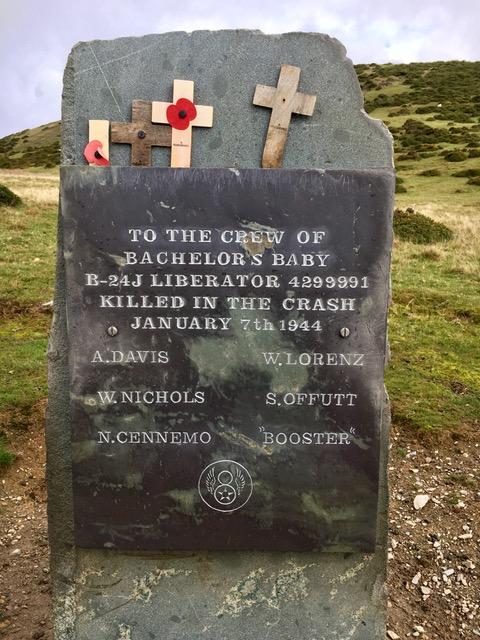

31 comments on “USAAF B-24J Liberator 42-99991 ‘Bachelors Baby’”
Leave a Reply Cancel reply
Image Information
-
Full Size: 3392×2261px
Aperture: f/8
Focal Length: 10mm
ISO: 200
Shutter: 1/1000.0 sec
Camera: NIKON D3200


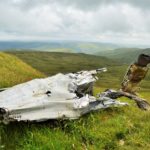
14/10/2016 Went up to see this today, cold and foggy. Sadly all the remaining parts appear to have been taken away.
been removed. Does anyone have any information on this?
The memorial stone had been removed for restoration work and is now back in its location and fully restored.
Incidentally there tends to be a memorial service at the site each remembrance Sunday – CHECK LOCAL PRESS OR PENMAENMAWR EYE ON FACEBOOK
Interesting news, thanks Dave.
If you have a photo of the restored memorial stone it would be good to add it to this narrative?
I visit this crash site often and love the walk up to the site. Always poppies on Remembrance Day. The youngsters are informed of what occurred up here all those years ago and are shocked as they didn’t know anything about it. The historical society are in the process of renewing the plaque as the writing has been affected by the weather. Any thing you want re photos please let me know and I will gladly oblige you
Hi Kevin, a photo of the restored memorial would be lovely if you have one? Will add to the narrative with a credit of course.
Thanks,
Ian
Thank you for the remembrance. I had a crew member on the plane that I was never able to meet and love
My family and I tried to find the site today. We must have been very close but somehow managed to miss it, again as we tried once before. We walked up from the farm up towards the ‘rocky mound’ with the quarry on our right hand side. We walked all the way around the back of it then down and back onto the path, obviously missing it somehow. Where did we go wrong please?
Thanks
Hi Donna,
Bummer you haven’t found it after two attempts.
The crash site is at grid reference SH 71560 74342, circled here.
Hope this helps,
Ian
Thank you. We plan on trying again in the coming weeks. Fingers crossed we will find it.
Good luck. Let us know how you get on?
Hi,
Do you have a walking route from either Penmaenmawr or Llanfairfechan?
Or What 3 Words address?
My Great Grandfather. PC Tom Thomas took airman Boyer to Llandudno hospital.
Would like to walk up.
Thank you, David.
Hi David,
The what3words reference is
mutual.grumbles.crawled
Ian
Hi, Than you for this harrowing, moving and interesting account. According to information to hand,the site will be visited tomorrow and a wreath laid in memory of those lost.
Hi Rob, thank you for your comment. It pleasing to hear of people remembering this crash and the men who died here (and of course the dog) especially on the anniversary.
Ian
I just read the full account of what happened to the men on board
the Bachelor’s baby, and sorry I did. I wished I hadn’t known how
my brother died. He was S/Sgt. Samuel Louis Offutt. and one of the
2 crew that were killed in the plane.
I know my brother Sammy is in Heaven all these years but how painful to have read every detail of his suffering. I guess I
shouldn’t have been so inquisative. He was a brother of 10 sibblings and so very much missed. They are all together in Heaven with my parents and Sam today, except me. Helen .I will be 90 yrs. old in May. Thanks for the crews Remembrance .
thanks for your personal e-mail
Went to pay my respect the other day to all in the B24 bacherlors baby specially the fellas that lost there life’s with booster the mascot very interesting read is there any more pictures of the plane intact?
Hi Warren there may well be other photos of the B24 but I don’t have any. I searched online but could find none, the one here I had to pay for, if memory serves. If you do come across any, it would be good to add them here!
Glad you got to the crash site to pay your respects.
Ian
My husband’s grandfather flew with Bachelor’s Baby for most of his military career and then later on the Yankee Maid. I have been trying to find more pics of the plane and him. His name is Monroe Holtz. He was a ball turret gunner. Any pics or info I would be very grateful for.
Hi, it was my dad who created the memorial in 1980 and carried it from a helicopter to the site. I have photos of the day if interested.
Hi Glyn, it would be great to see and add the photos from the day.
Please scan and copy to me and I will upload them in the main narrative with a credit to you and your dad.
Many thanks,
Ian
I am the great-great-nephew of SSGT Offutt and Aunt Helen. My mom and I were reading through the correspondence we have to and from Sammy while he was part of the instructional squadron before deployment to England, as well as letters to and from our family and SGT “Whitey” Alexander following the crash alongside other documents. Digging deeper online, I quickly found this article. I wholeheartedly want to thank you for such thorough documentation and memorializing Sammy and the rest of the crew of the Bachelor’s Baby. So much more going through my head but I will leave it there for now. Thank you so much, again. I will hopefully visit across the pond one day.
Thank you very much, I’m pleased you found this page and that it has been of help to you.
Best wishes to you and your family,
Ian
Ian,
I wonder if you can fill in some blanks. Sammy was listed at KIA with the 399th Bomb Grp, 604th Bomb SQ. The 399th was assigned to the 2nd then 4th Air Force and is listed as a operational training then replacement training group with all State-side airfields.
Researching the Bachelor’s Baby, the plane is listed as lost as part of the 8th Air Force, which would make more sense being they were moving to an operational deployment. Do you have any more specific information regarding their Group or Squadron at the time of the crash? I know Whitey was reassigned to the 551st Bomb SQ of the of 385th Bomb Grp of the 8th Air Force as an armorer following the crash. He stated his first flight back up was a food drop to the Dutch… interesting reading his account given the depiction of those missions in Masters of the Air. All to say, I’m interested in the circumstances of 42-99991’s deployment to the European Theater and what unit they were attached to… or, unfortunately, were supposed to attach to.
Thanks, in advance, for your insight as we dive deeper into Sammy’s service.
-Mike
Hi Mike,
I have sent an email with a number of attachments to the email address you used to log in to comment here (I can see it but others can’t). The files are quite large so please let me know if you don’t get them and I will compress them and resend.
Alas, I don’t know the answer to your question. I suspect the plans for 42-99991 had not been determined?
Interesting to read of Sgt Alexander’s war. I too watched Masters of the Air, have watched it a couple of times now. It’s very good.
Best wishes,
Ian
Samuel Offutt is listed as DNB
(Death Non-Battle) not KIA.
Hi – I have additional information about one of the men on this plane – Sgt. Nicholas N. Cennemo who was hitching a ride with this crew and was killed in the crash. Would love to share some information with his descendants. Do you have any helpful information?
Hi Mark,
I don’t personally but some of the crew’s relatives have visited this page, so someone might see your comment and be able to connect you.
Best wishes,
Ian
Hello, Ian,
I am the niece of Sgt. William Lorenz, who died on the day after the crash of “Bachelors’ Baby.” In July, I was privileged to be able to visit both the crash site as well as my uncle’s resting place in the American Military Cemetery near Cambridge. I have learned so much about the circumstances of the crash from Adrian Hughes of the Home Front Museum in Llandudno, from the interactive display at the Penmaenmawr Museum, and from this webpage. I will now pursue Edward Doylerush’s book to learn still more.
Thank you so much,
Carol Ann Lorenz
Thank you Carol, I’m pleased you got to visit the crash site. Doylerush’s book has loads in it.
Best wishes,
Ian